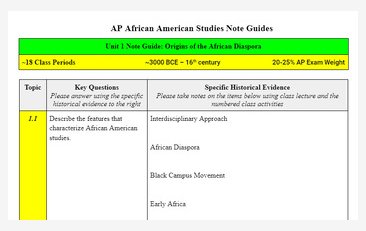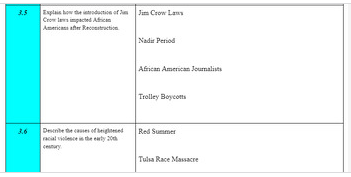The Note Guides for AP African American Studies: An Essential Resource for Students and Teachers
- Rethink History

- Apr 10
- 4 min read
In today's educational landscape, there is a growing emphasis on recognizing diverse cultures and histories. With this focus, resources like The Note Guides for AP African American Studies have become increasingly important for both students and teachers. Developed over two years, these guides align closely with the AP Course and Exam Description, making learning and teaching more effective and relevant.
These Note Guides cover every aspect of the curriculum, ensuring that students and educators are fully prepared for the academic challenges of the 24/25 school year. I accredit my students' 100% AP Pass rate to this philosophy and practice in my course.
Benefits for Students
The benefits of incorporating The Note Guides for AP African American Studies are numerous and designed specifically for high school students readying for AP exams.
Lecture Notes
Effective note-taking during class is key to academic success. The Note Guides allow students to capture essential information seamlessly, which helps them understand the detailed aspects of each topic. For instance, a student might document critical points about the Harlem Renaissance, making connections to key figures like Langston Hughes or Zora Neale Hurston.
Reading Notes
Assigned readings can be extensive in AP courses. The Note Guides have special sections for summarizing key points from textbooks and articles. By organizing their notes, students can better retain information—research shows that organized note-taking can improve retention by up to 30%. This method also serves as an excellent foundation for exam preparation.
Left-Side Questions
To foster engagement, the Note Guides include synthesis questions inspired by the College Board. These questions are similar to the Short Answer Questions (SAQs) and Long Essay Questions (LEQs) that appear on the AP exam, allowing students to practice critical thinking and connect the dots between various concepts—a skill essential for scoring well on the exam.
Unit Summary
At the end of each unit, the Note Guides encourage students to summarize their learning. A fun twist is the ability to create memes that capture the unit's essence, which not only promotes creativity but makes studying enjoyable and memorable.

Advantages for Teachers
Teachers find immense value in The Note Guides for AP African American Studies, aligning perfectly with their planning and instructional needs.
Academic Terms
New educators, in particular, can significantly benefit from the right-column academic terms. This feature helps them become familiar with essential terminology, allowing for confident and informed instruction—which can lead to increased student engagement.
AP Exam Weighting
Each Note Guide provides clear AP Exam Weighting percentages for key topics, along with suggested lesson plans and timelines (for example, covering important events from 1491 to 1607). This clarity helps teachers prioritize topics based on their importance for the exam, thus streamlining lesson planning.
Comprehensive Coverage
With the Note Guides, educators can effectively plan the course and unit calendar. By ensuring every topic in the course description is addressed, teachers maximize their students' chances of success on the AP exam. The inclusion of completed notes from the previous year saves hours of preparation time, allowing teachers to focus on delivering enriching content.
Synthesis Questions
The Note Guides offer a variety of synthesis questions that mimic actual AP exam prompts. Practicing these questions prepares students not just for what to expect but also helps them understand the format and how to articulate their thoughts clearly.

Classroom Integration Tactics
Integrating The Note Guides for AP African American Studies into classroom learning is both simple and effective. Educators can use the guides as continuous resources throughout the year or for specific review sessions leading up to the exam. For example, a timed essay prompt based on synthesis questions could be employed in a mock exam, enhancing students' preparedness.
By organizing lessons around the Note Guides, teachers foster a collaborative and interactive atmosphere that encourages participation and critical thinking. This teaching method deepens students' understanding of African American history and its relevance today.
Transforming the Learning Journey
The Note Guides from Rethink History aim to enrich both teaching and learning experiences, aligning with AP standards while catering to varied educational styles.
Teachers utilizing these guides benefit from a resource that simplifies their planning, boosting student engagement. At the same time, students enjoy personalized learning journeys that encourage them to examine themes in depth and with creativity.
This dual approach shifts the study of African American history from simple memorization to a meaningful exploration of cultural significance. It invites students to engage critically with the material, allowing for a richer educational experience.
The Future of Education
As the educational landscape evolves, resources like The Note Guides for AP African American Studies are becoming crucial for fostering a deeper understanding of diverse histories. Their comprehensive design not only supports exam preparation for students but also equips teachers with the necessary tools for effective instruction.
For both educators and students, these Note Guides are invaluable resources that pave the way for academic achievements and a broader appreciation of African American studies.
By incorporating these guides, teachers can create inclusive and engaging learning environments, cultivating a more informed and culturally aware student body that recognizes the significance of history and its lessons for today and the future.








Comentarios